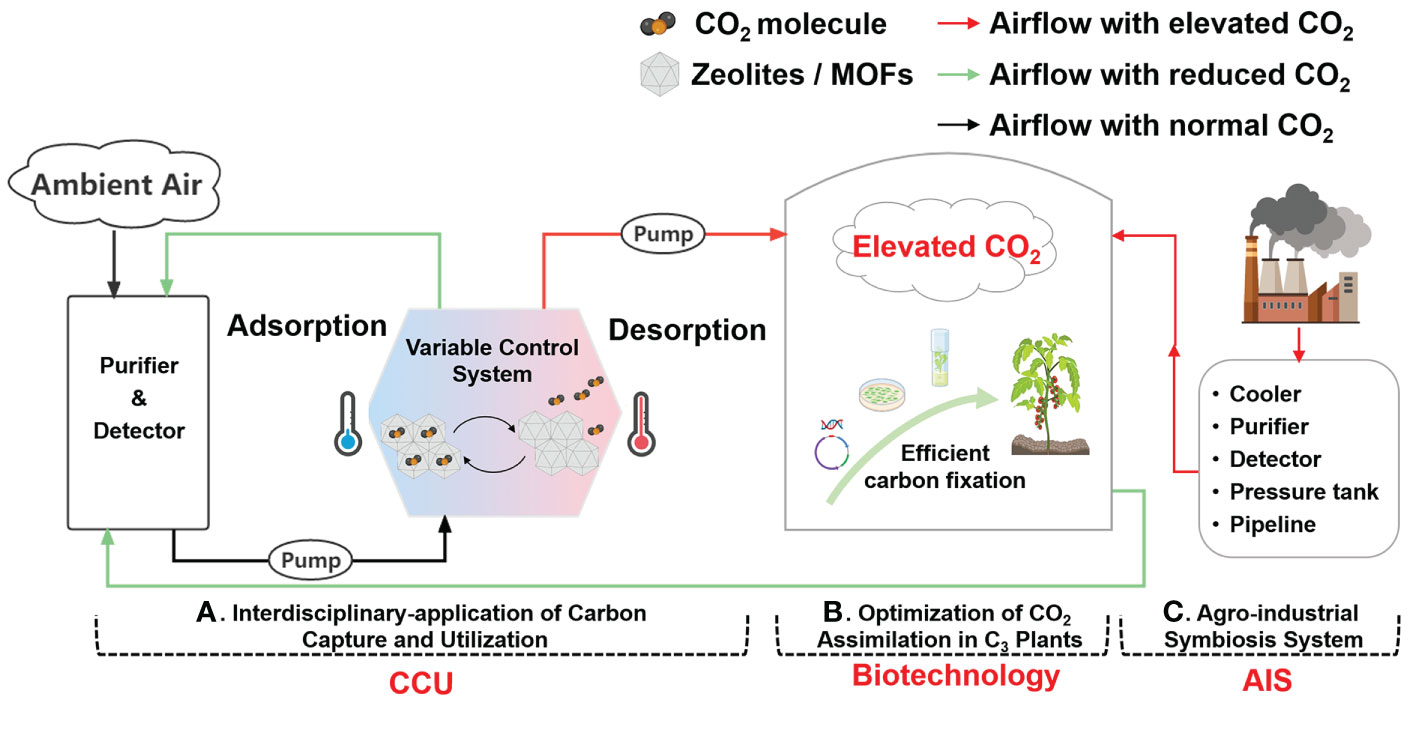Jul 22, 2024
Harnessing Direct Air Capture (DAC) Technology for Indoor Farming

Image source: https://www.frontiersin.org/journals/plant-science/articles/10.3389/fpls.2022.1029901/full
July 22, 2024
Authors: Ankur Garg, Niko Simos
Indoor farming and CO2
Indoor farming relies heavily on the use of carbon dioxide (CO2) as it is crucial for plant growth and productivity. Here are the key points on the importance of CO2 for indoor farming:
- CO2 is essential for plant photosynthesis and growth. Plants use CO2 from the air and convert it into sugars that fuel their growth and development. If CO2 levels drop below 250 ppm, plant growth will stop.
- Indoor farming operations need to replenish the CO2 that is removed from the farm during harvesting. When plants are harvested, the carbon-rich plant matter is removed, depleting the CO2 in the growing environment. Growers must actively supplement CO2 to maintain optimal levels for continued plant growth.
- Proper CO2 supplementation can boost plant yields by around 30%. Most indoor farms aim to maintain CO2 levels between 800-1200 ppm, as this range optimizes the CO2 uptake and utilization by plants.
- CO2 can also be used as a natural pest control method in indoor farms. High CO2 concentrations of 5% or more over 4 days can kill insects without harming the plants.
Managing CO2 levels is critical for the success of indoor farming operations. Growers use methods like burning fuels, releasing bottled CO2, or using decomposition processes to supplement CO2 and maximize plant growth, productivity, and pest control.
The two main methods of enriching CO2 levels in indoor farming facilities - burning fossil fuels like natural gas or propane, and releasing compressed CO2 from tanks - are not environmentally friendly for the following reasons:
- Burning fossil fuels releases significant amounts of CO2 and other greenhouse gases into the atmosphere, contributing to climate change. While effective at supplementing CO2 levels for plant growth, this method has a large carbon footprint.
- Releasing compressed CO2 from tanks, while simpler, is less cost-effective and energy-efficient than burning fuels. Although it doesn't directly produce additional emissions, the production and transportation of pure CO2 tanks still have an environmental impact.
To mitigate the environmental impact, indoor farms should explore alternative CO2 enrichment methods.
What is Direct Air CaptureDAC?
Key Components of Direct Air Capture:
Regeneration Processes: Once captured, the CO2 needs to be removed from the sorbent material. This step is crucial for regenerating the sorbent and releasing concentrated CO2 or CO2-enriched air for subsequent utilization or sequestration. The regeneration can be done using different methods, e.g. heat, low pressure, chemical processing, or a combination of both.
Benefits of Direct Air Capture:
Resource Utilization: Captured CO2 can be utilized in various industrial processes, contributing to the circular economy, and reducing reliance on fossil fuels. Additionally, in the realm of indoor farming, greenhouses, and vertical farms, the captured CO2 can enhance plant growth by increasing the concentration of CO2, which is a critical component of photosynthesis. This not only improves crop yields and efficiency but also supports sustainable agricultural practices by reducing the need for external carbon sources.
Carbon Neutrality: DAC offers a pathway to achieve carbon neutrality by actively removing CO2 from the atmosphere and offsetting emissions from various sources and industries. By incorporating DAC into indoor farming systems, such as greenhouses and vertical farms, the captured CO2 can be recycled back into the agricultural cycle, further promoting a sustainable loop. This integration helps to balance the carbon equation by both sequestering carbon and using it to foster plant growth, thereby contributing to a more holistic approach to carbon management and environmental stewardship.
Versatility: Unlike traditional carbon capture technologies, DAC is not limited to specific point sources, making it applicable in diverse settings and geographical locations.
Climate Resilience: DAC provides a proactive approach to climate change mitigation, offering a means to directly address atmospheric CO2 concentrations and their associated impacts.
Direct Carbon (“DC”)
Direct Carbon builds a simple, easy-to-use, affordable direct air capture (DAC) technology that captures CO2 from the atmosphere and repurposes it for the indoor growing environment for its plant growth. With their patented technology, they create a closed-loop system where they take in air from the greenhouse, enrich that with captured CO2, and pump it back into the greenhouse at a higher PPM level.
Their compact machine, the Wunderpumpe Aurora, weighs under 70 kg and occupies less than a cubic meter of space, making it ideal for container farms, in-store farms, and small indoor vertical farms. Utilizing cost-effective chemistry and the proprietary closed-loop system, Direct Carbon prioritizes keeping the total cost of ownership (TCO) low while ensuring energy efficiency in CO2 capture. This is just a start, aimed to build more machines with varying capacities and specifications suitable for vertical farms of all sizes.
Their user-friendly online platform simplifies the task for growers to oversee and manage our machinery, offering seamless integration capabilities with their pre-existing climate control systems. Their plug-and-play solution is designed for easy installation, operation, and maintenance. Direct Carbon offers their product as a service, eliminating upfront investment for customers, and facilitating their transition from fossil CO2 setups to a fully circular approach.
Direct Carbon’s Wunderpumpe successful launch at Greentech
Conclusion
In the realm of indoor farming, where precision and sustainability are paramount, the adoption of Direct Air Capture (DAC) technology represents a pivotal advancement. Traditional methods of CO2 enrichment, such as burning fossil fuels or using compressed CO2 tanks, pose significant environmental challenges, from carbon emissions to energy inefficiencies. These methods not only contribute to climate change but also contradict the principles of sustainable agriculture.
DAC offers a transformative solution by directly capturing CO2 from the atmosphere, independent of emission sources.
